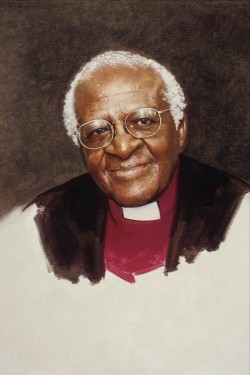Baroness Thatcher
Oil on canvas, 24 x 20 inches, 2001 Sold on behalf of the British Forces Foundation
‘I needed to capture something of the strength and determination that a nation has always attributed to her. The trademark blue suit, the ubiquitous handbag not far from her side and the perfect coiffeur.’
‘I do hope the light in here is all right for you?’ enquired Lady Thatcher, extending a hand to greet me. She listened attentively while I explained how I hope the sittings would progress. It was clear she wanted to give of her best and be a good sitter. With some minor adjustments to the room, a comfortable armchair was positioned so all the light fell gently across her face. Coffee was summoned and the first of many enjoyable sittings began.
It was the beginning of a new adventure. Margaret Thatcher had been such an influential Prime Minister, much revered by my family and an inspiration to many of my generation. Her reputation was well known, as was her appearance from countless photographs and caricatures. I started work on the portrait a few days after meeting her for the first time. Not wanting to record just a superficial likeness, I needed to capture something of the strength and determination that a nation has always attributed to her. The trademark blue suit, the ubiquitous handbag not far from her side and the perfect coiffeur succinctly enshrined the public perception of the country’s first lady Prime Minister.
With a ramrod straight back and hands neatly clasped in her lap, we gradually broke into conversation. There was talk of the Brighton bombing, the Falklands war, her friendship with Ronald Reagan and most surprisingly, traditional home cooking. Memories of the Falklands took an emotional turn. With a catch in her voice, recalling the lists of casualties brought the reality of the conflict, fought far away, back home. Recollections of the SAS invasion strategy were graphically illustrated all over the tea table, with the cups and saucers, sugar bowl, milk jug and teapot used as landmarks to describe the scene.
At times, the conversation was vigorous, with robust opinions expressed giving me moments to see the fire still behind the eyes. Although each sitting would be an hour and a half in length, time would fly as I flung paint on the canvas. Often oblivious to an agitated secretary wanting to draw things to a close, our time together would regularly overrun. On many occasions, when I was tired from the intense concentration, I would be invited to stay on for a drink to relax and continue our conversation. After a time, there emerged a softer, more tender aspect to the Iron Lady. She would ask questions and listened carefully to my responses.
It was at moments such as these that I was able to see a more sensitive side that I felt it was necessary to allude to in the portrait. There emerged a different woman, with a kindness, a good humour and indeed a gentleness that was not revealed in the painting. Although the picture was practically finished, I was about ready to start all over again, as I now felt that I knew here how she really was.
Whilst I had invited Lady Thatcher to view the work as it evolved, she made it clear that she would prefer to see it only on completion. When the work was finished, she stood quietly contemplating her image. Placing a hand up to here pearl necklace and considering her words carefully, she remarked ‘It is how one would like to be remembered.’
‘Little did I know at the time that this would be the first of six portraits I would paint of her.’





